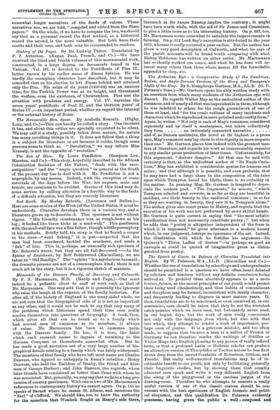Memorials of the Danvers Family, of Dauntsey and Culworth. By
F. N. Macnamara, M.D. (Hardy and Page.)—One must indeed be a pedantic churl to scoff at work such as that of Mr. Macnamara. One may add that it is generally the ignorant who raise the laugh at the expense of the family historian. For after all, if the history of England is one many-sided whole, we are not sure that the biographical aide of it is not as important as any other, and it would not be rash to say that very many of the problems which historians spend their time over really resolve themselves into questions of biography. A book, then, which gives all that can be found as to a family which had several men of eminence as its members, is always of value. Mr. Macnamara has been at immense pains with the Danvers family. He has, it is true, the habit which such research seems to ingrain of returning to the Norman Conquest or thereabouts somewhat often. But he has made a good narrative out of a very large number of bio- graphical details relating to a family which was fairly widespread. The members of that family who have left most name are Charles Danvers, who figured so unhappily in Essex's rebellion ; Henry Danvers, who held the Earldom of Danby, the friend and kins- man of George Herbert ; and John Danvers, the regicide, whom later friends have considered as better than those with whom he was associated. But, generally, we may say that we have a long pro- cession of country gentlemen. With one or two of Mr. Macnamara's references to contemporary history we cannot agree. On p.145 he speaks of Barnet where he means St. Albans, and mentions the "Earl" of Clifford. We should like, too, to know the authority for the assertion that Wenlock fought on Henry's side there, inasmuch as Sir James Ramsay implies the contrary; it might have been worth while, with the aid of Sir James and Commines, to give a little more as to his interesting history. On p. 397, too, Mr. Macnamara seems somewhat to antedate the improvements in farming. On p. 312 Lord Say's execution is attributed to the year 1451, whereas it really occurred a year earlier. But the author has given a very good description of Culworth, and what he says of the parish accounts will be found worth comparing with what Bishop Hobhouse has written on other series. Mr. Macnamara has evidently worked con amore, and what he has done will in- terest many others than those whose names fill the formidable appendix to chap. xiv.


















































 Previous page
Previous page